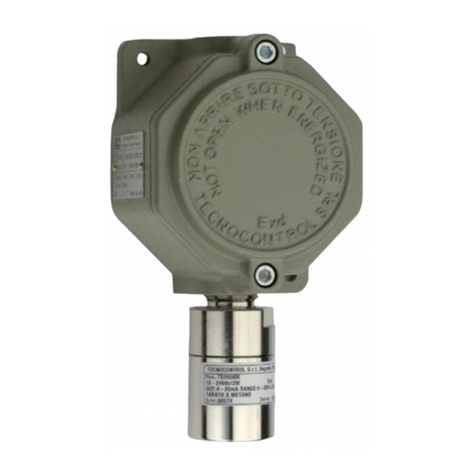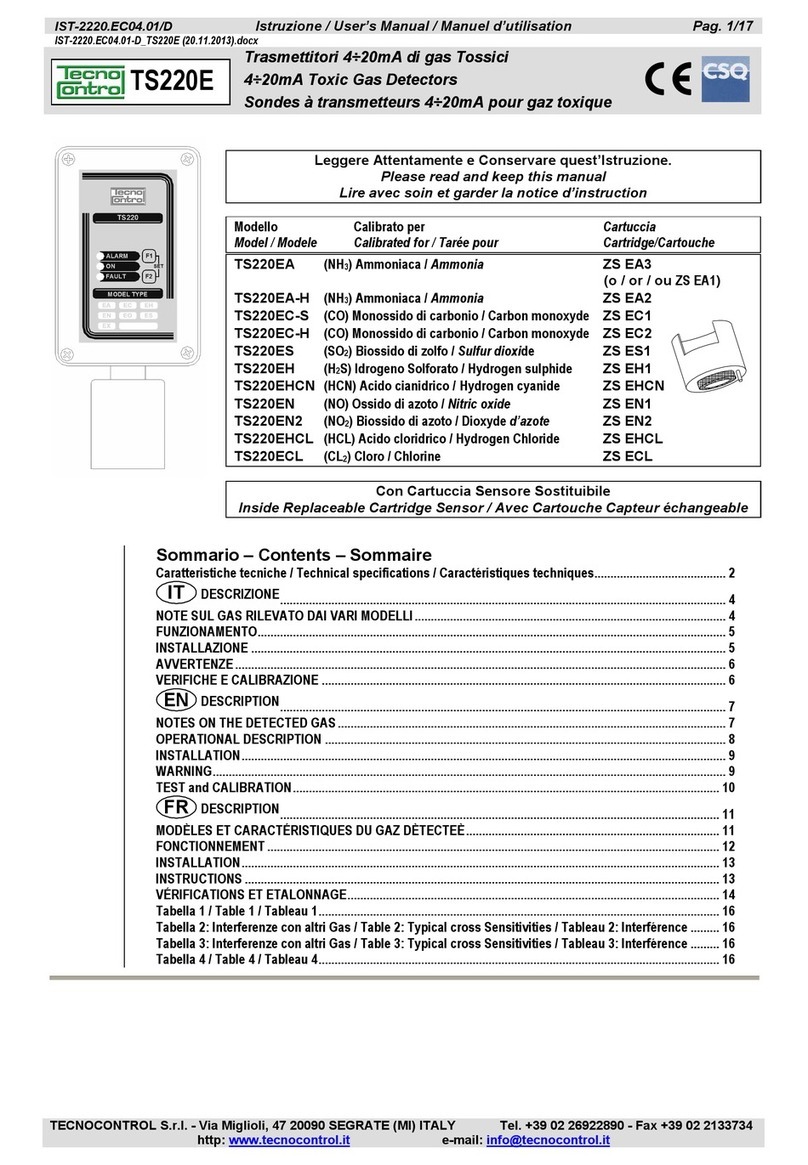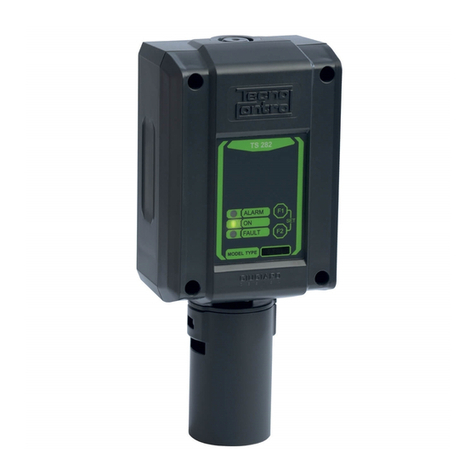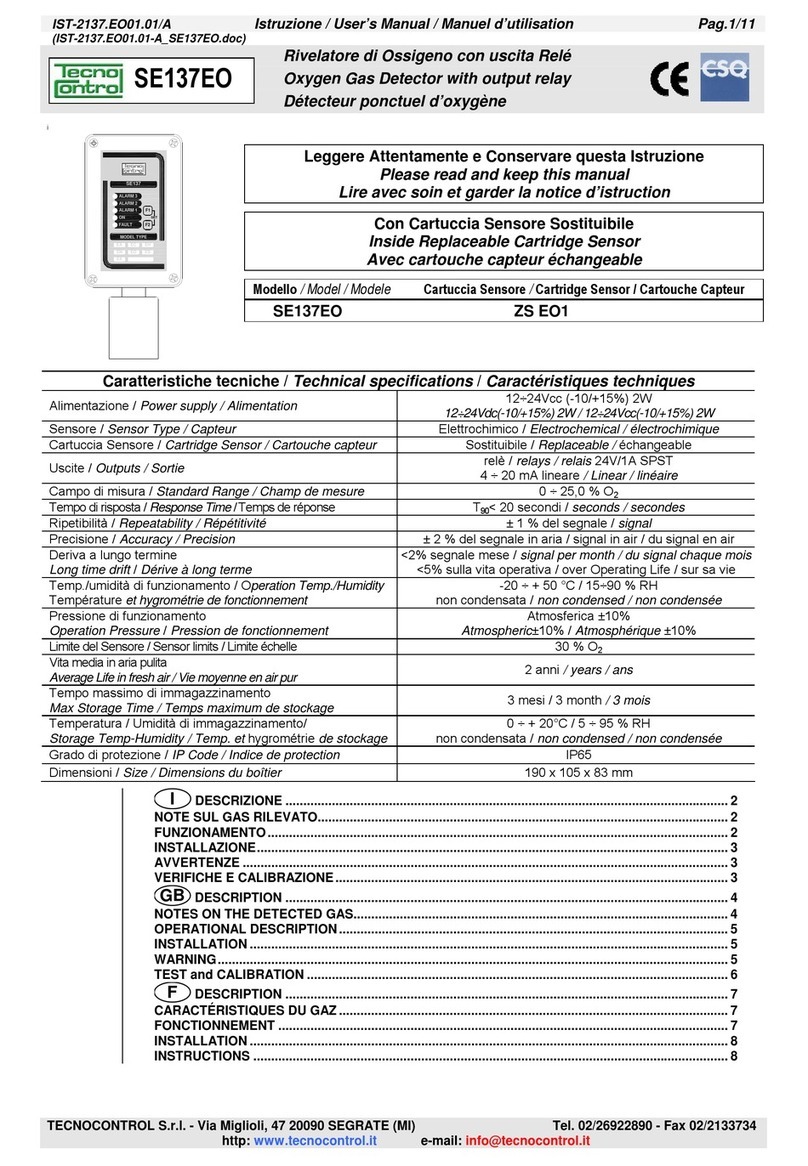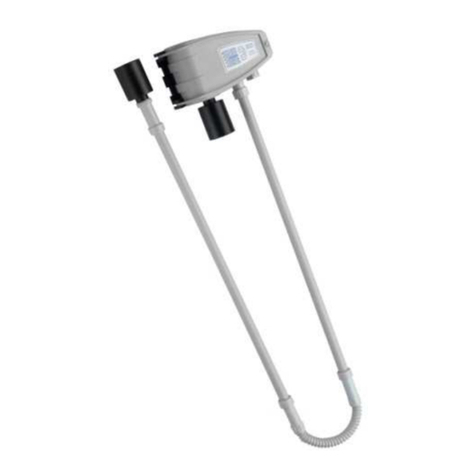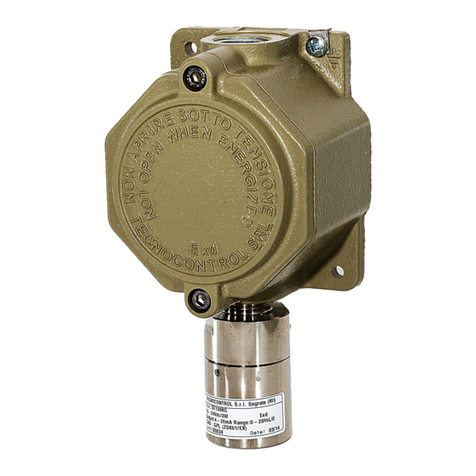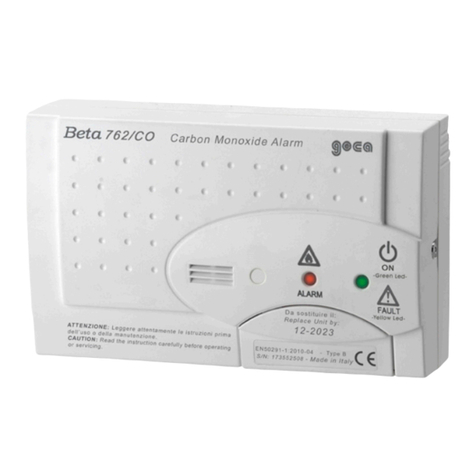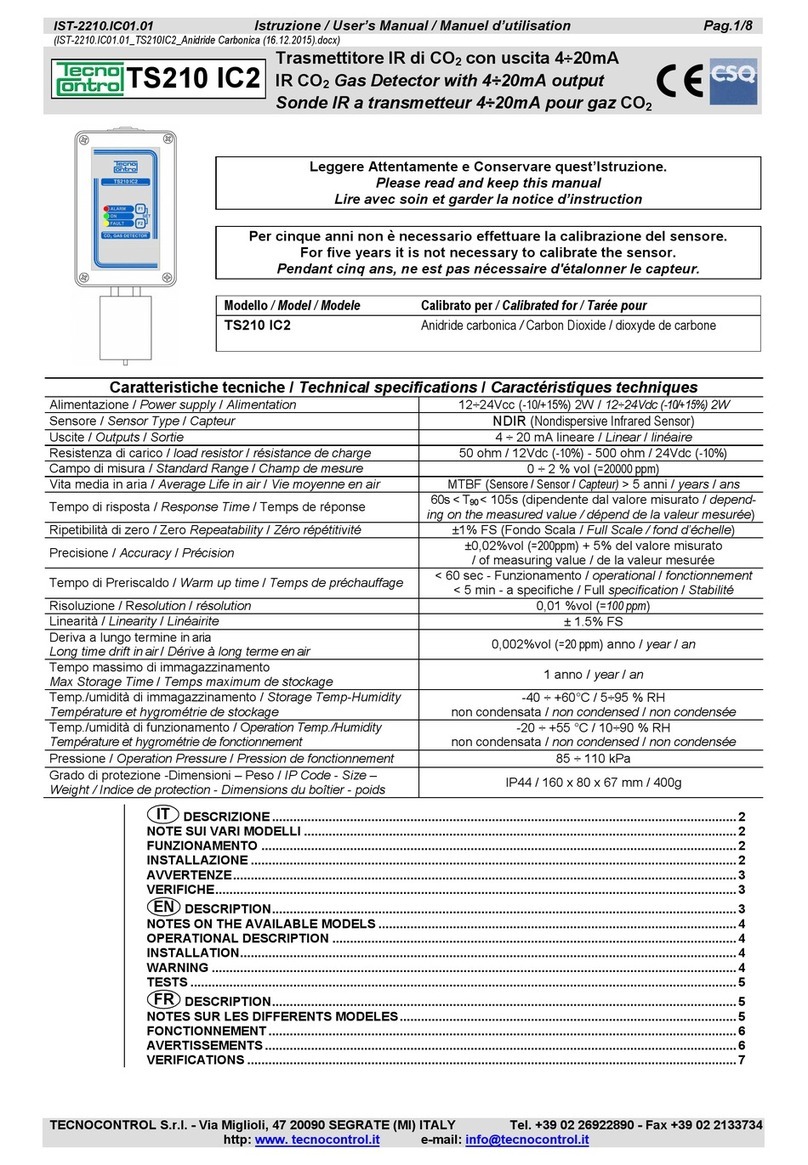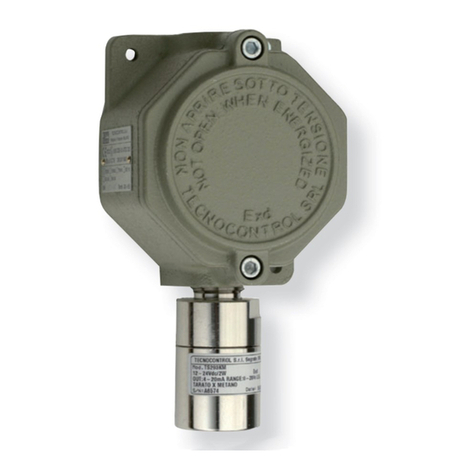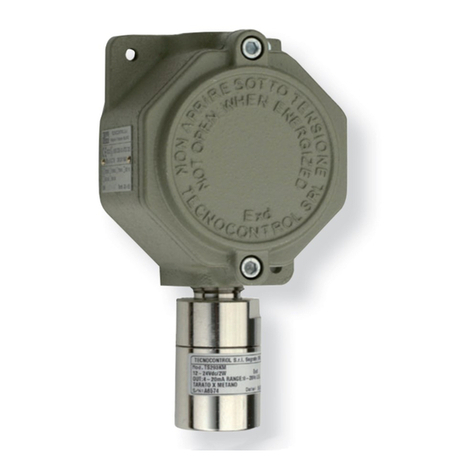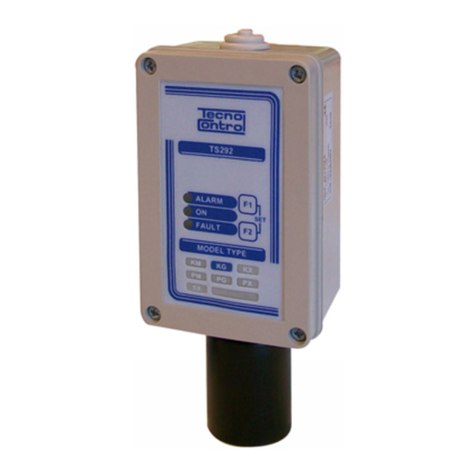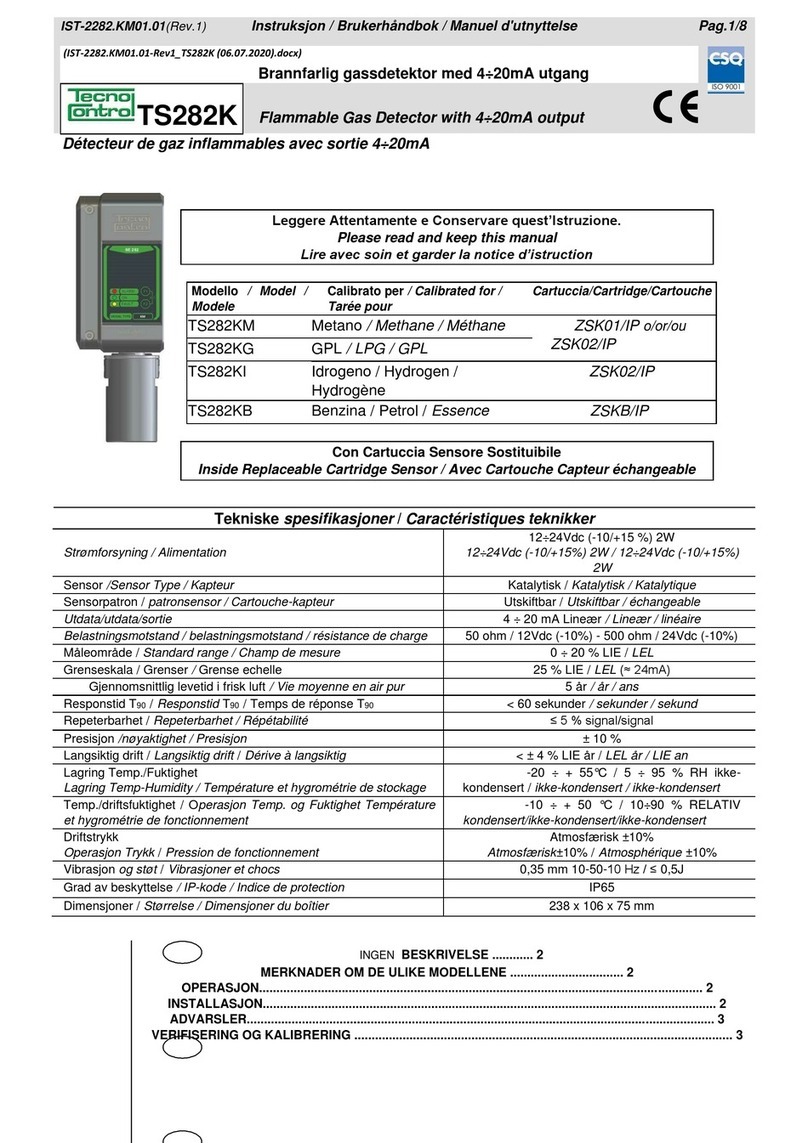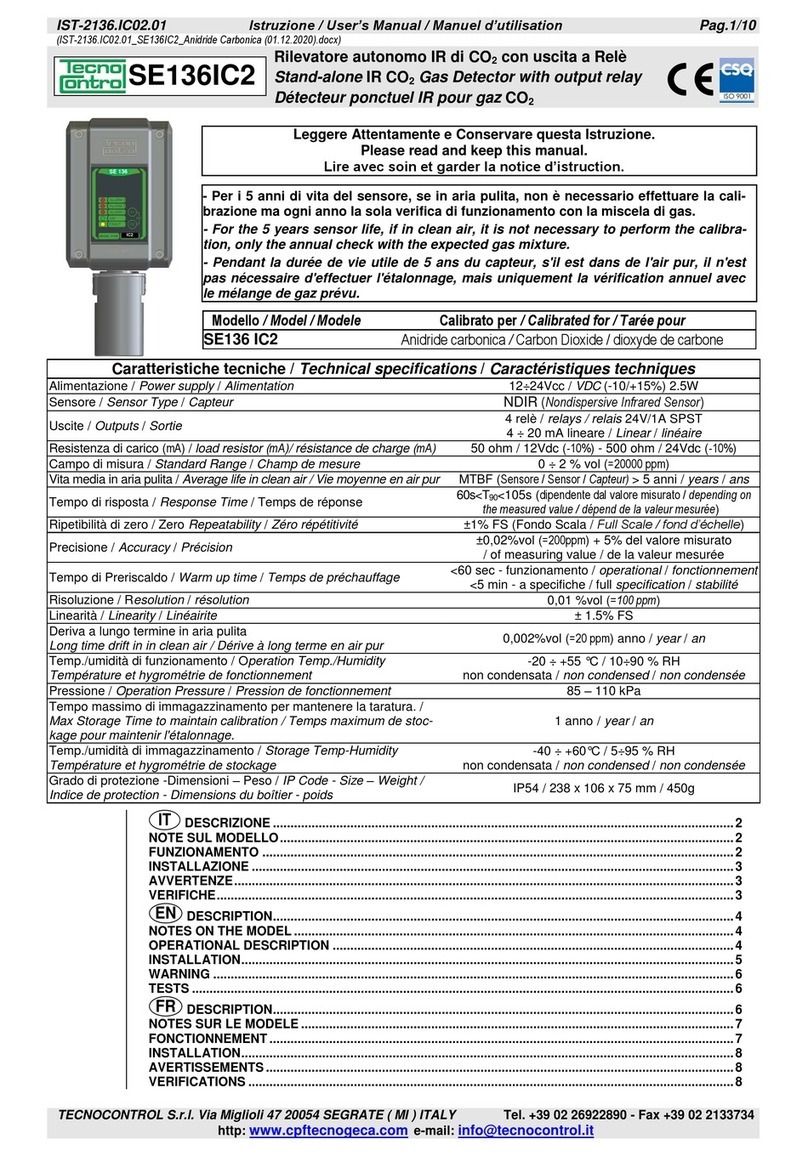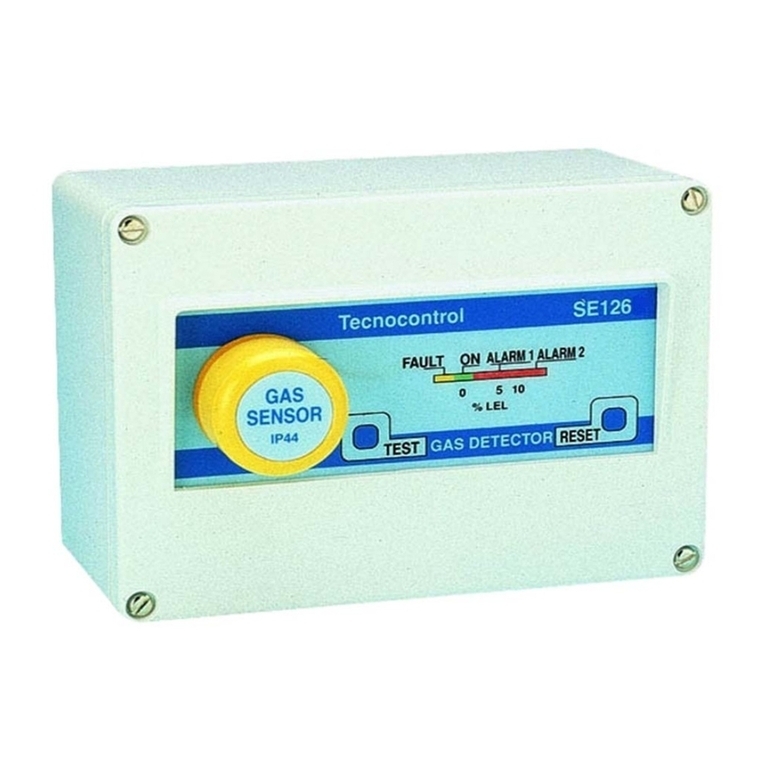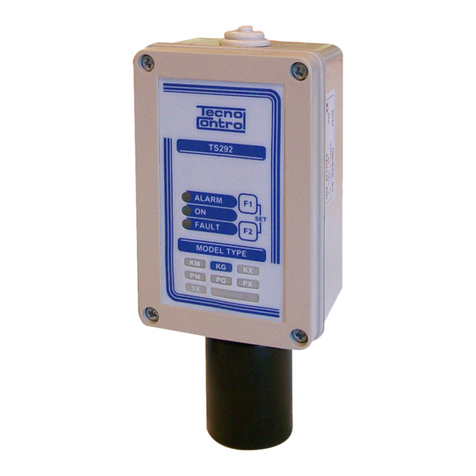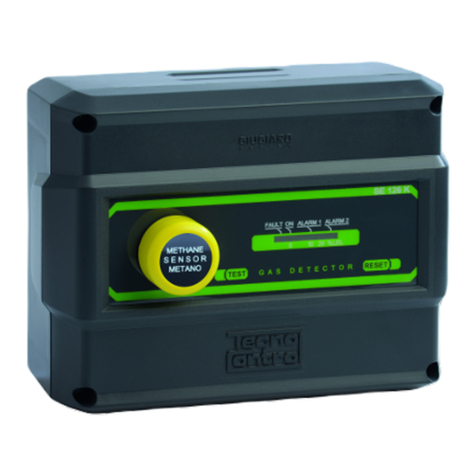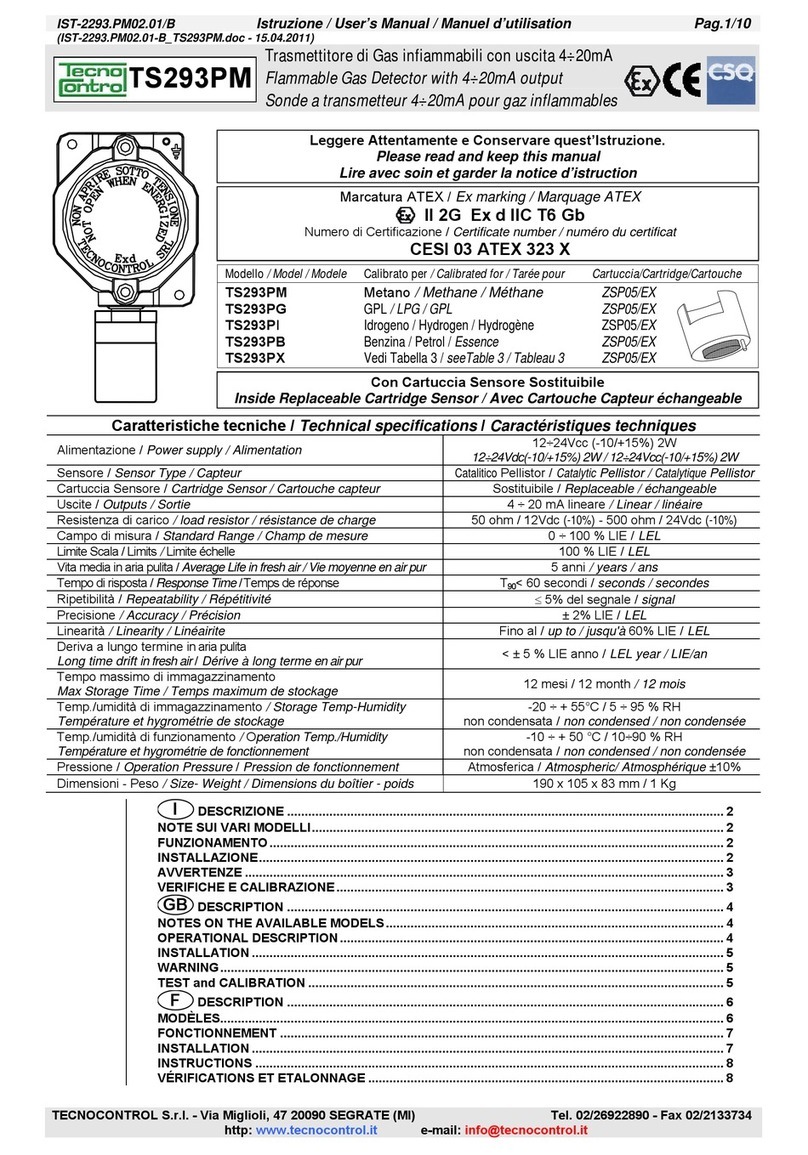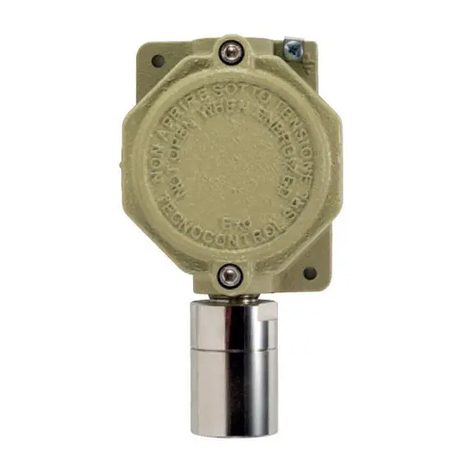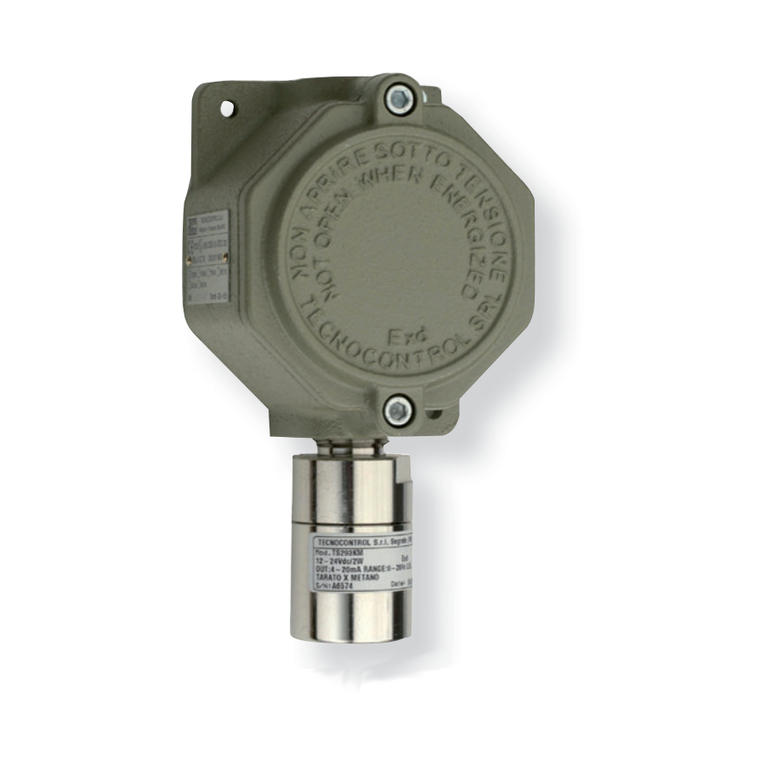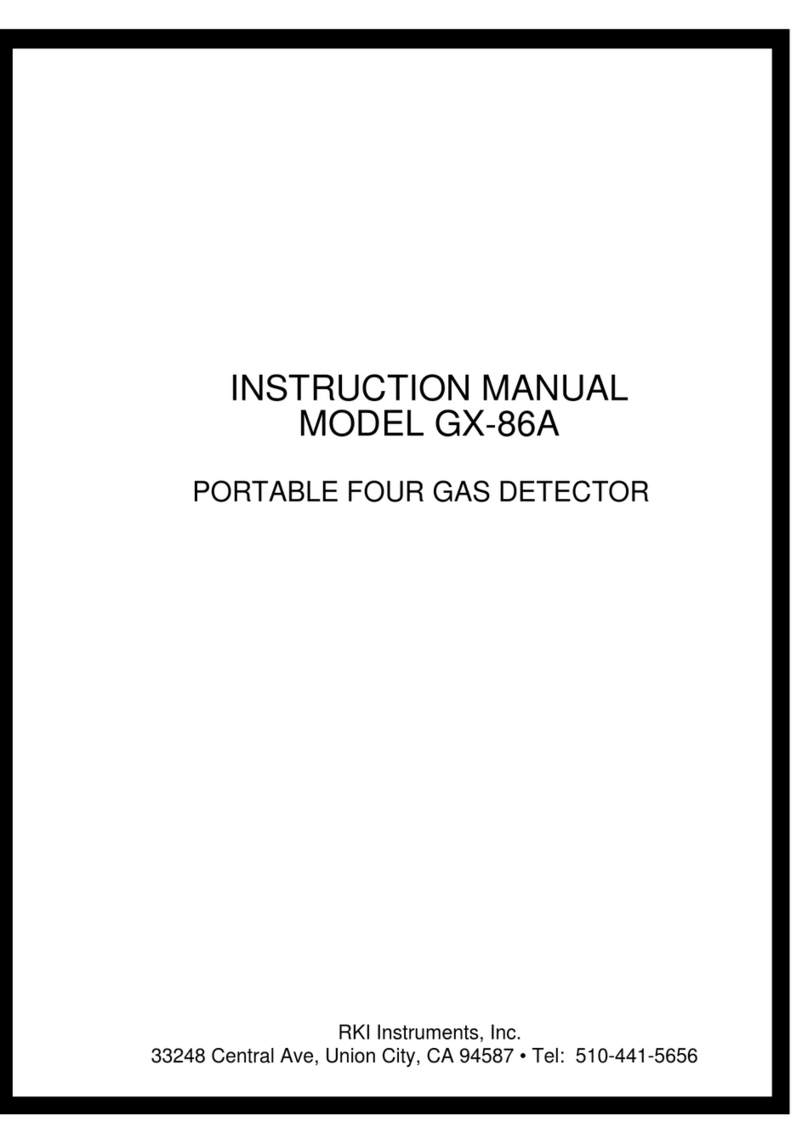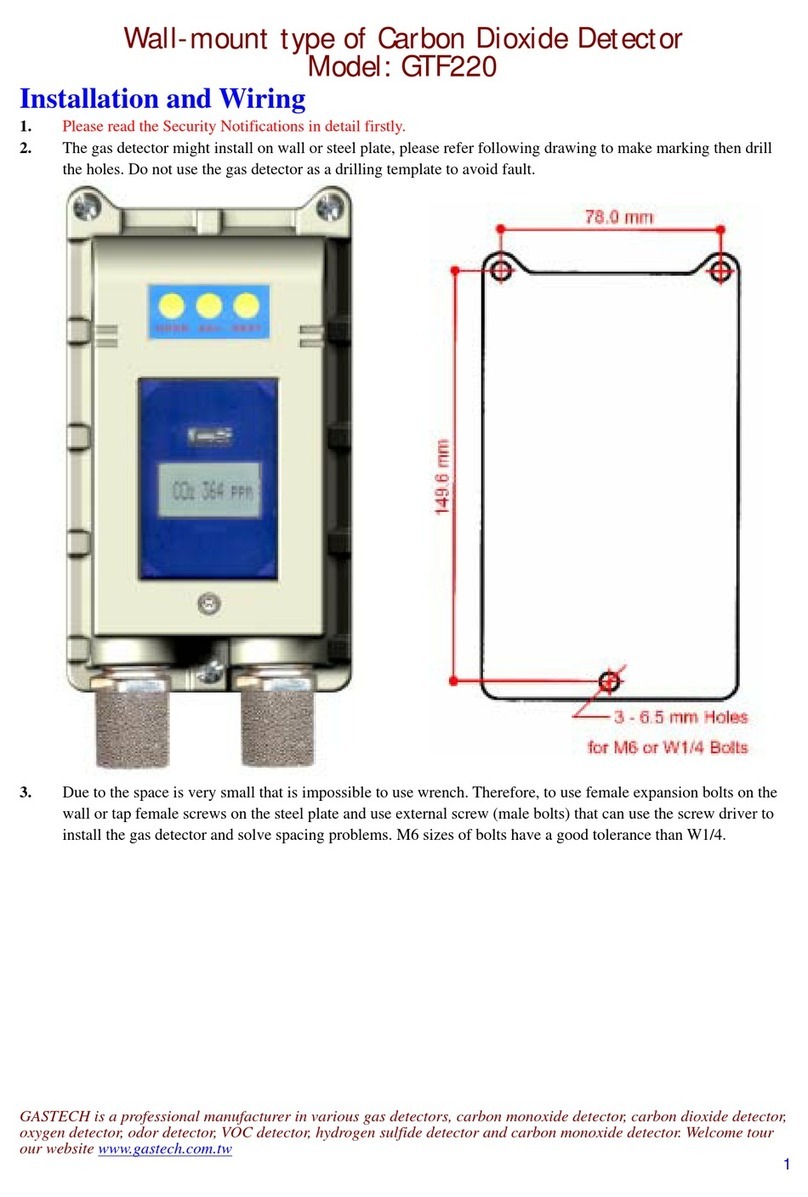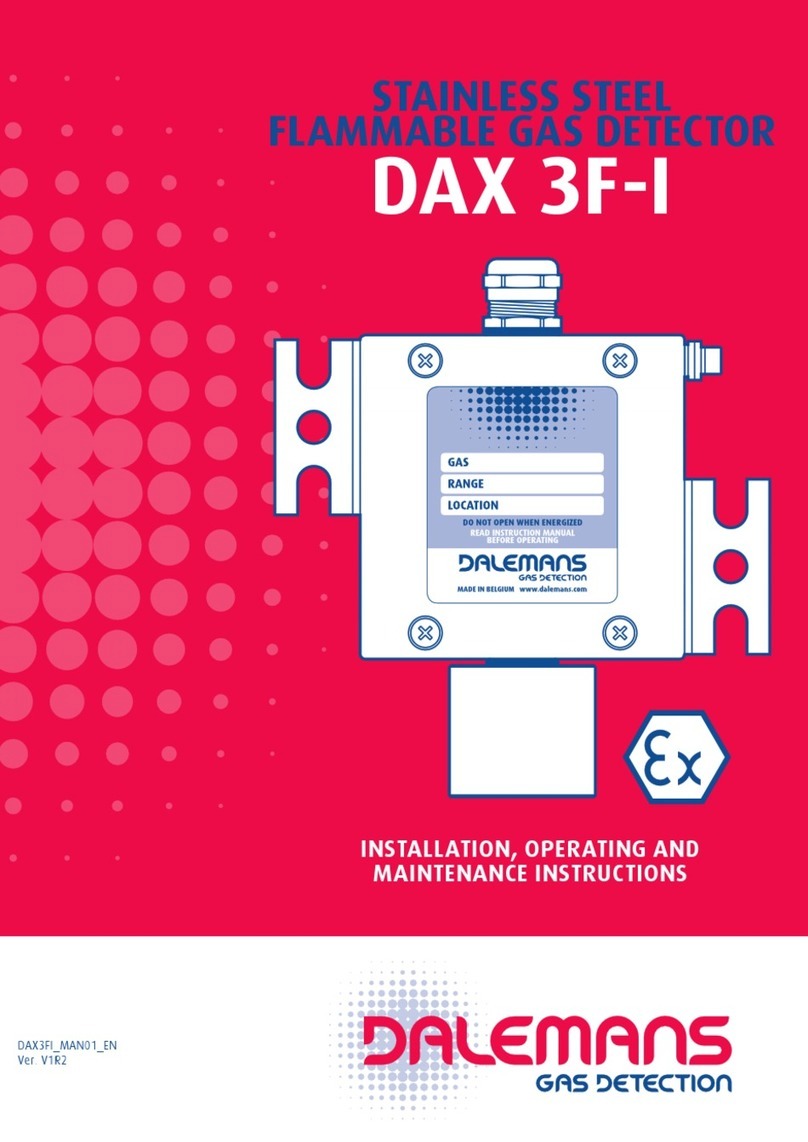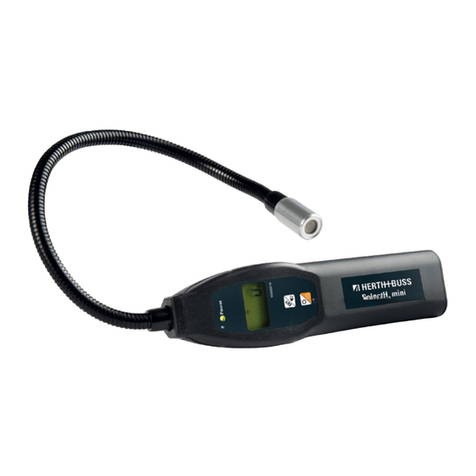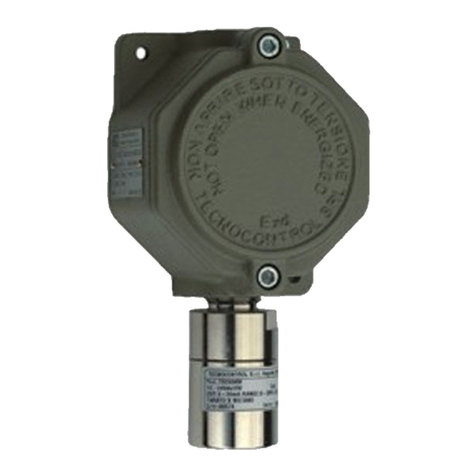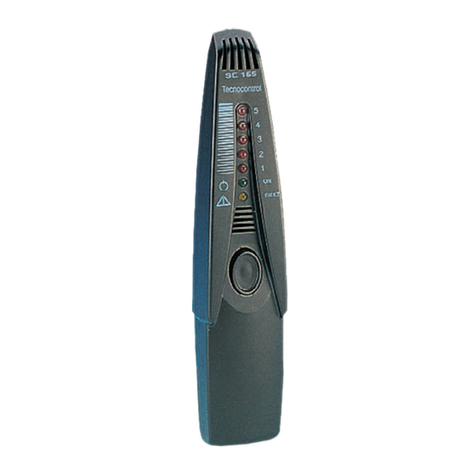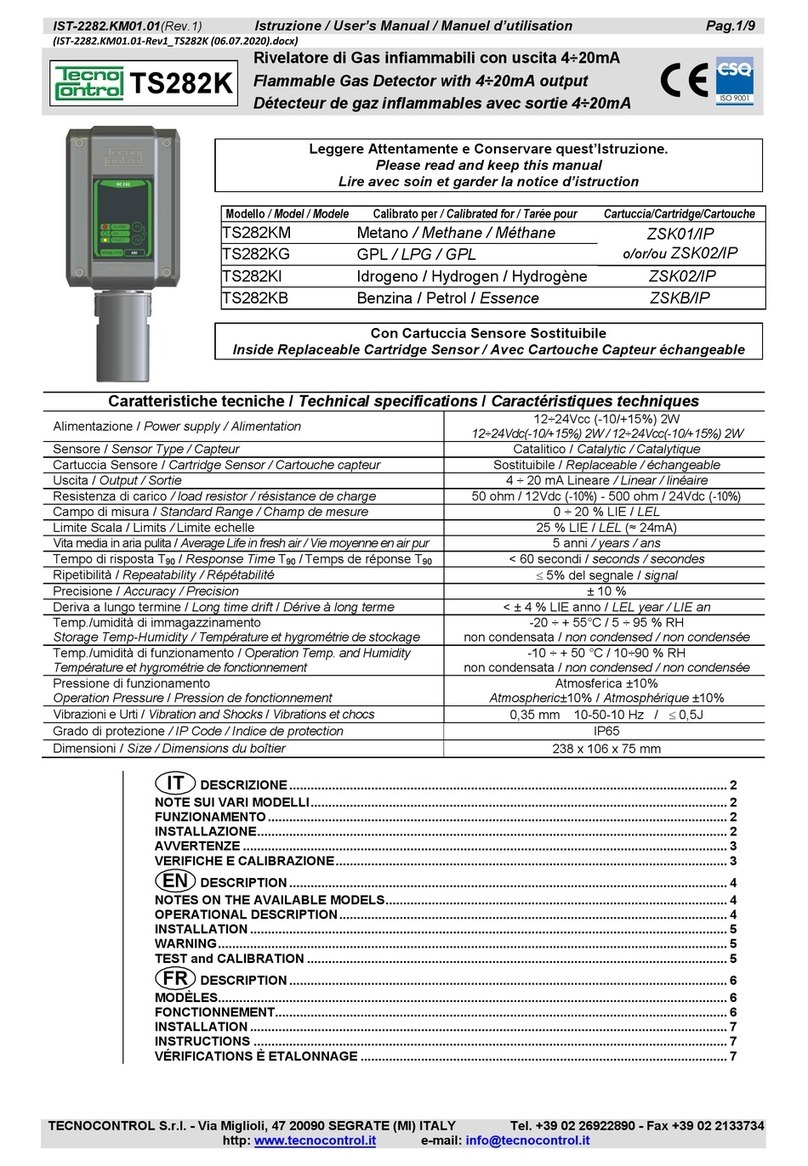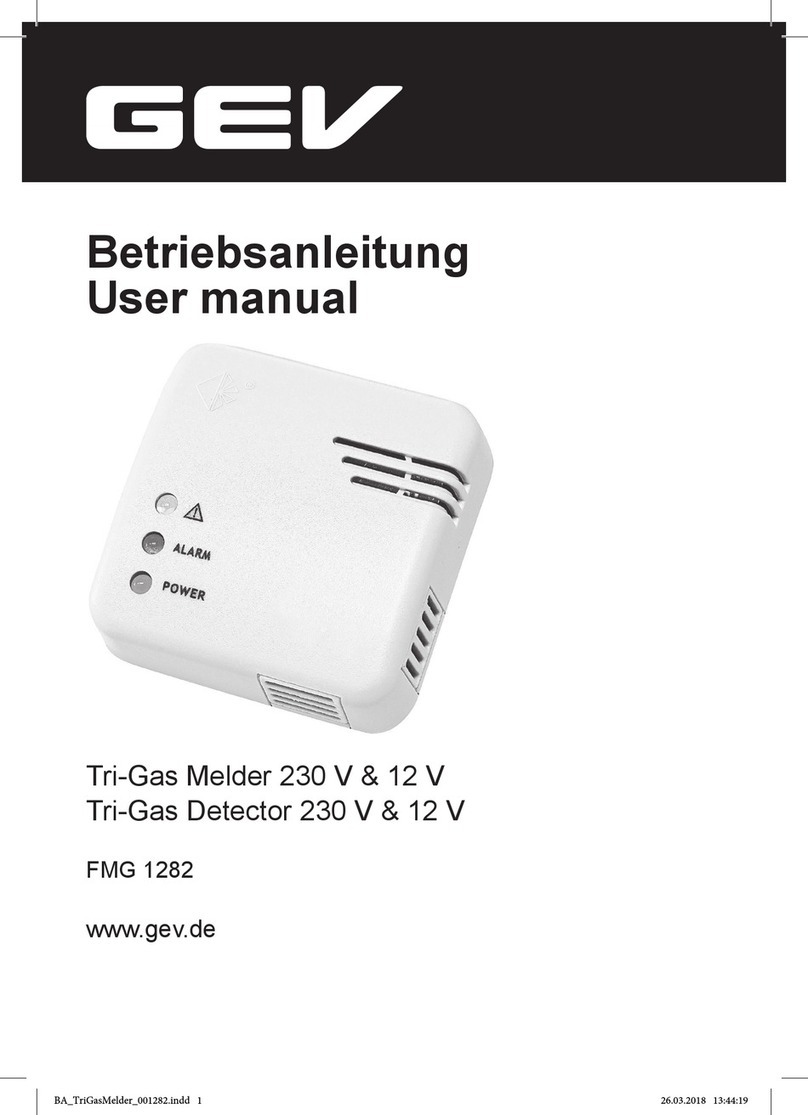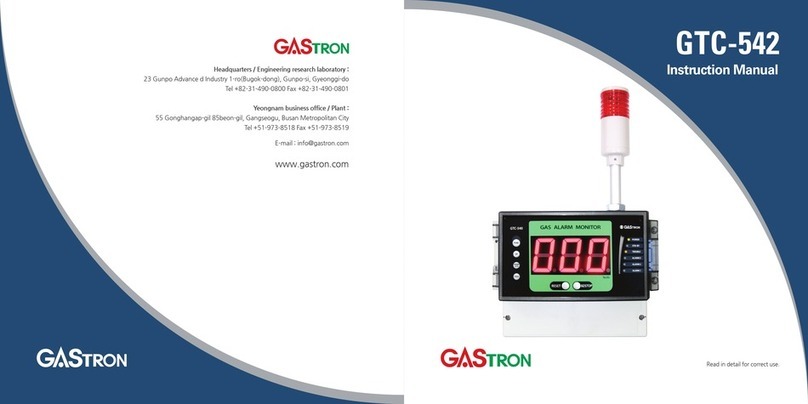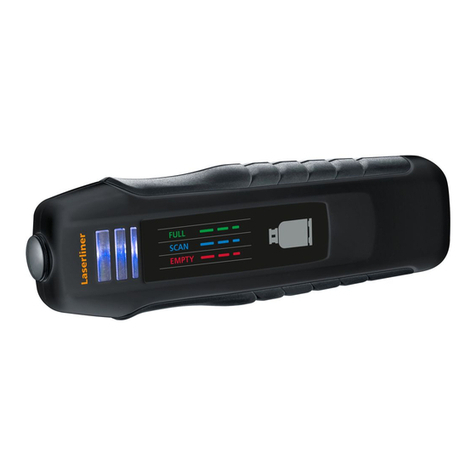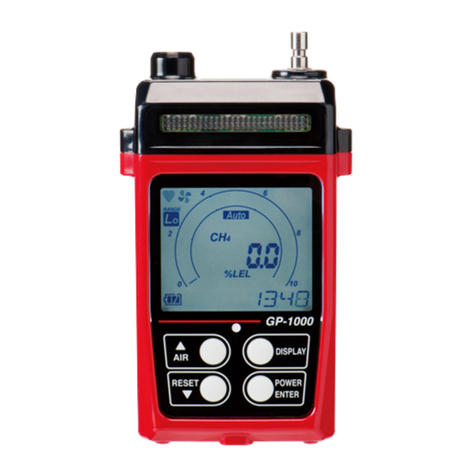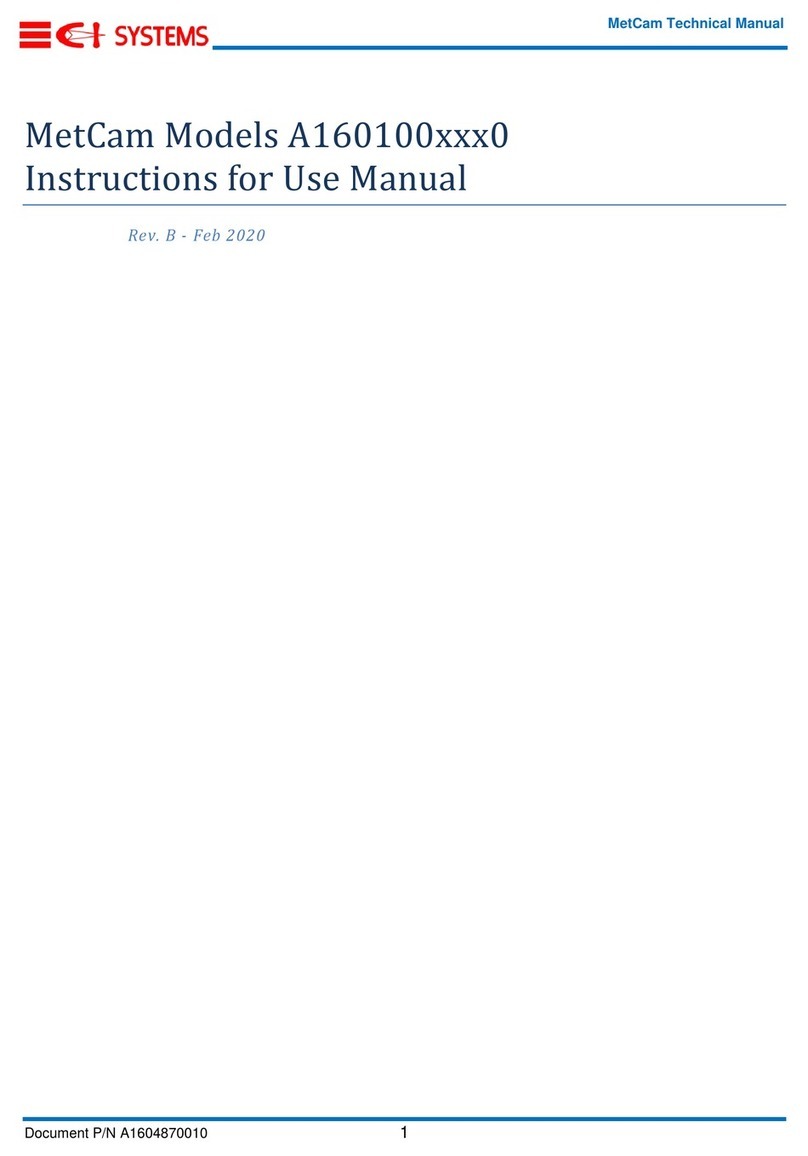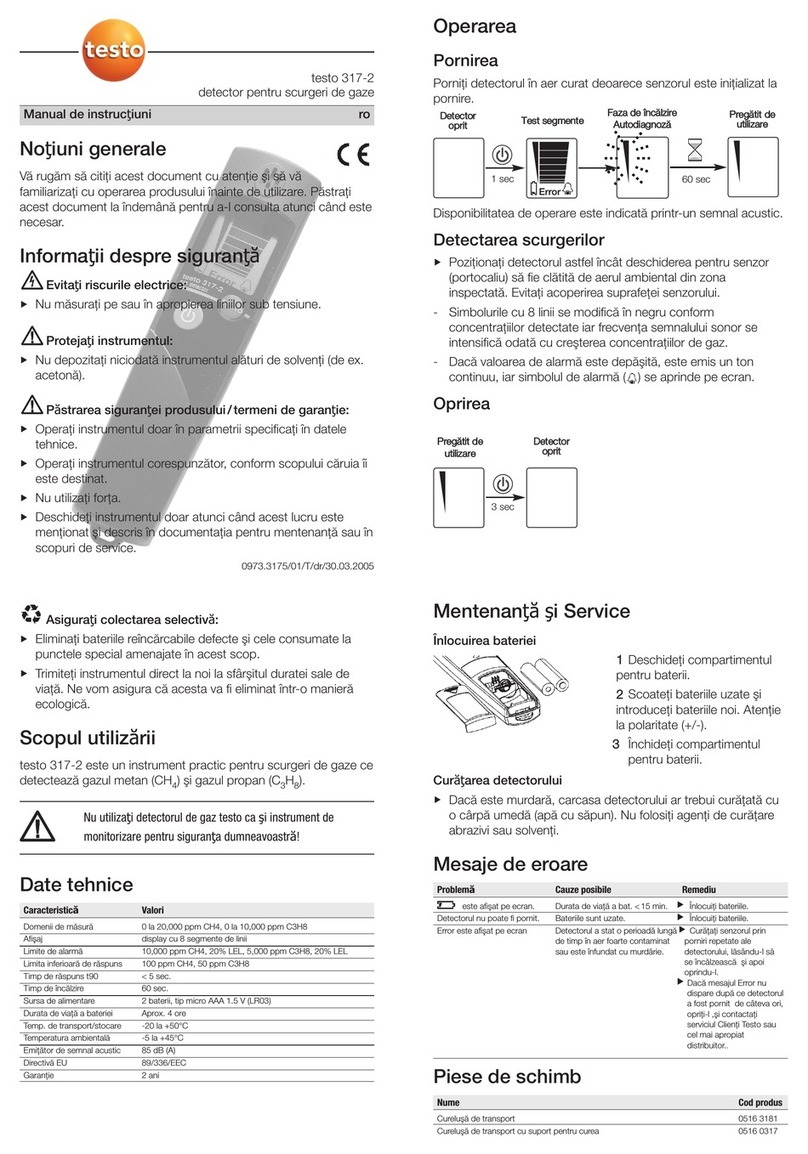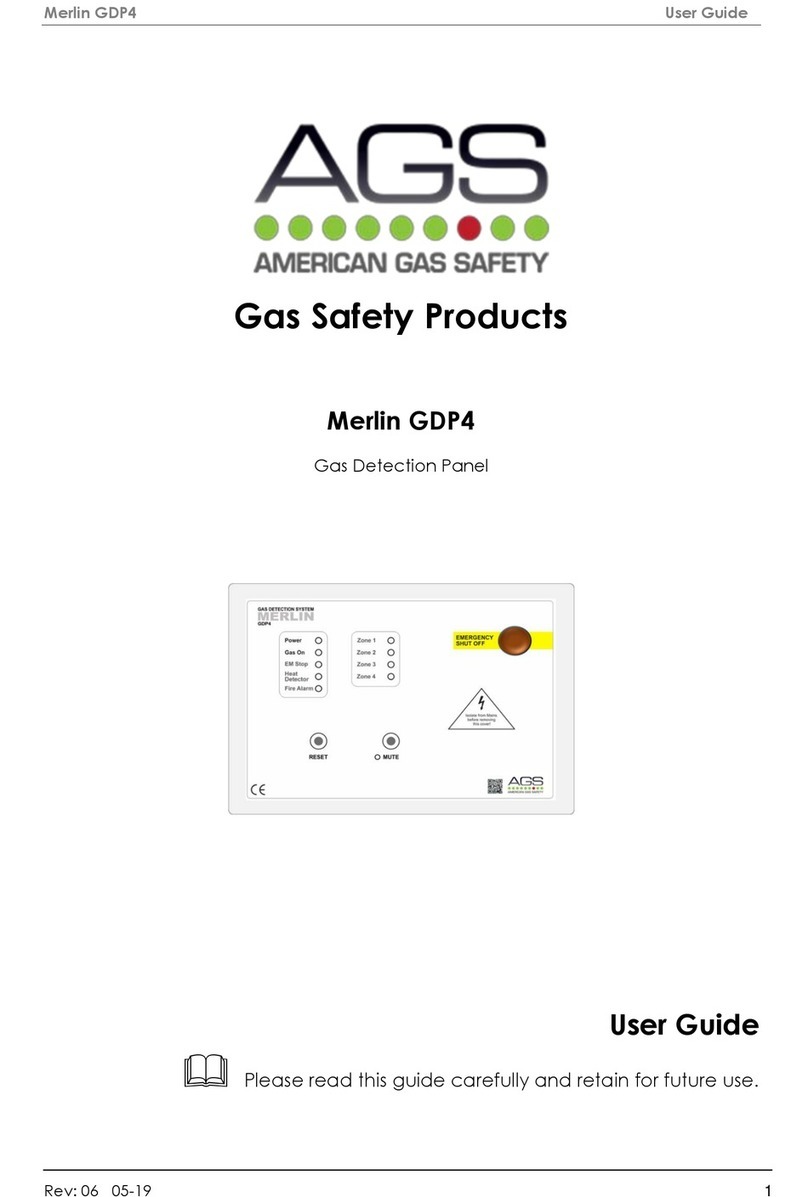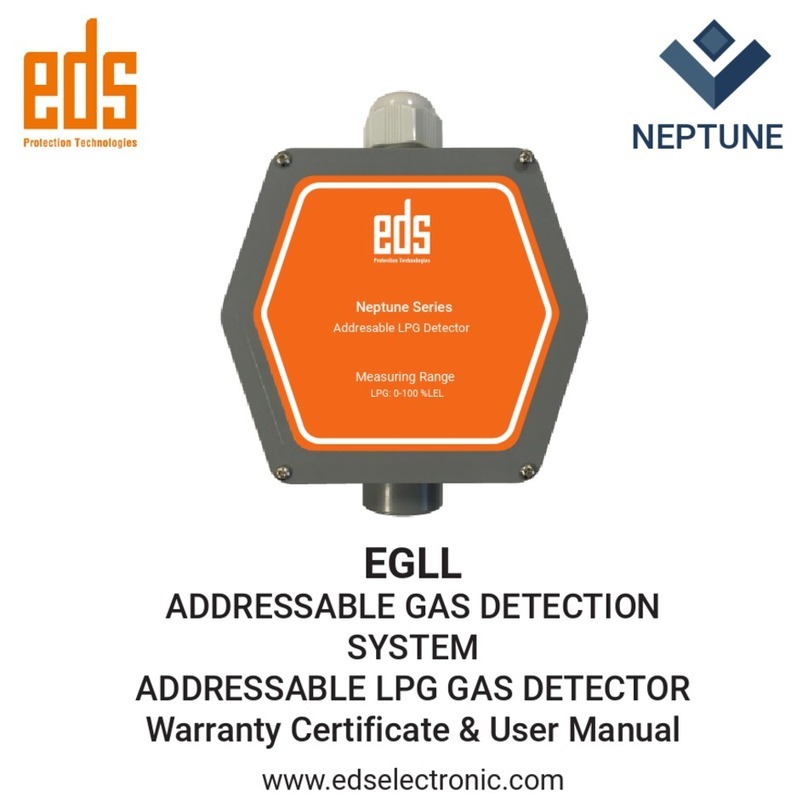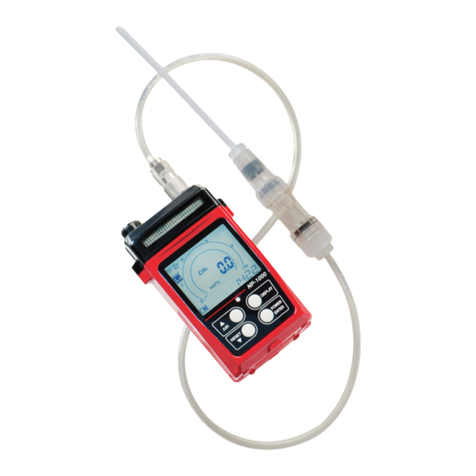
Pag./Str. 2/4K021ES-I10.20MK.0212-TSI
TECNOCONTROL S.r.l: Via Miglioli 97 SEGRATE 4373312/20:xaF09822962/20:leT)IM(
Dopo questo tempo il segnalatore è in
grado di funzionare regolarmente an-
che se necessita di 2÷3 ore per ripor-
tarsi nelle condizioni di stabilità e sensi-
bilità ottimali.
In condizione d'allarme, s'illumina il Led
Rosso (ALARM) e il segnale acustico
interviene dopo 15÷20 secondi. Se la
presenza del gas non è costante, il ri-
tardo riparte da zero. La condizione di
allarme termina quando la concentra-
zione del gas nell'ambiente diminuisce
sotto all'80% del punto di taratura.
INSTALLAZIONE
Posizionamento del Mod.SE120KM:
il Metano (CH4) è un gas più leggero
dell'aria, la densità relativa all'aria è
0,55, il suo LIE (Limite Inferiore di E-
splosività) è 5%v/v (Volume).
Il segnalatore va posto a 30 cm dal sof-
fitto, ad una distanza di 1-1,5 metri dal-
l'utilizzatore, ma non oltre i 3-4 metri e
lontano dagli angoli del locale o da pre-
se di ventilazione (Fig.1).
Il segnalatore non va installato in posi-
zioni con scarsa ventilazione; come ad
esempio tra soffitto e armadietti alti, so-
pra porte e finestre o sopra fonti di calo-
re quali frigoriferi, forni, lavabiancheria o
sopra il lavello.
Posizionamento del Mod.SE120KG:
il GPL è una miscela composta dal 20-
30% di Propano (C3H8) e dal 80-70% di
Butano (C4H10). La taratura per GPL
eseguita come richiesto dalla Norma
UNI-CEI 70028 con iso-Butano che è
un gas più pesante dell'aria, la densità
relativa all'aria è 2, il suo LIE è 1,8%v/v.
Il segnalatore va posto a 30 cm dal pa-
vimento, ad una distanza di 1-1,5 metri
dall'utilizzatore, ma non oltre i 3-4 metri
e lontano dagli angoli del locale o da
prese di ventilazione (Fig.2).
Il segnalatore non va installato in posi-
zioni con scarsa ventilazione; come ad
esempio dietro ad armadietti o tende,
vicino a porte, o vicino a fonti di calore
elevate.
Fissaggio e Collegamenti elettrici:
Per accedere ai morsetti, aprire la cu-
stodia infilando, nell'apposita fessura,
un adeguato cacciavite a taglio. Il se-
gnalatore è predisposto per l'installa-
zione a parete. (Fig.3):
1)praticare nel muro due fori con inte-
rasse 70 mm (A)
2)inserire i due tasselli a muro Ø 6 mm
in dotazione (B)
3)fissare la staffa con le due viti au-
tof.TC3,5x35 mm in dotazione (C).
4)infilare il segnalatore sulla staffa (D).
After this delay the instrument is
working correctly. However the gas
detector needs about 2÷3 hours'
time to get the stability and sensitiv-
ity conditions as to factory labora-
tory calibration.
In case of an alarm condition, the red
LED illuminates. After 15÷20 seconds
the buzzer activate. During this lapse of
time, if the gas concentration either is
not constant or fluctuates around the
calibration point, the time delay restarts
from zero. When the gas concentration
in the environment decreases below
80% of the calibration point, the red
LED switches off and the buzzer stops.
INSTALLATION
Model SE120KM positioning:
Methane (CH4) is a combustible
gas lighter than air. Its density re-
lated to air is 0.5-0.65; its LEL
(Lower Explosion Limit) is 5% v/v
(Volume).
The instrument should be fixed at 30
cms from the ceiling and be placed at
1-1.5 meter from the gas appliance (no
more than 3-4 meters), far from the
room corners or from ventilation intakes
(see Fig. 1).
Avoid installing the detector in low
ventilated environments such as be-
tween the ceiling and high cup-
boards, over windows and doors, or
over heating sources such as re-
frigerators, ovens, washing ma-
chines or over the sink.
Model SE120KG positioning: LPG
is a gas mixture composed by 20-
30% Propane (C3H8) and by 70-
80% Butane (C4H10). As per thye
Italian Standard CEI UNI CIG
70028, LPG calibration must be car-
ried out with Butane which is a
combustible gas heavier than air. Its
density related to air is 2; its LEL is
1.5%v/v .
The instrument should be fixed at
30 cms from the floor and be placed
at 1-1.5 meter from the gas appli-
ance (no more than 3-4 meters), far
from the room corners or from venti-
lation intakes (see Fig.2).
Avoid installing the detector in low
ventilated environments such as
behind cupboards or curtains, near
doors or high heating sources.
Mounting and Wiring connection:
To get access to the terminals,
open the case by inserting a screw-
driver in the suitable slot.
The gas detector can be wall
mounted (Fig. 3):
Po tomto oneskorení bude prístroj pracovať
správne. Avšak detektor plynu potrebuje
asi 2-3 hodiny na stabilizáciu a dosiahnutie
správnej citlivosti, ktorá je rovnaká ako
pri kalibrácii v laboratóriu výrobného
závodu.
V prípade alarmového stavu sa rozsvieti
červená LED dióda na prednom paneli. Po
15 - 20 sekundách sa aktivuje bzučiak.
Počas tohto stavu, aj keď koncentrácia nie
je konštantná alebo kolíše okolo kalibrač-
ného bodu (10% LEL), časové oneskore-
nie sa bude počítať od nuly. Keď koncen-
trácia plynu v miestnosti klesne pod 80 %
hodnoty kalibračného bodu, červená LED
zhasne a bzučiak sa vypne.
INŠTALÁCIA
Umiestnenie detektora SE120KM:
Metán (CH4) je plyn ľahší ako vzduch. Jeho
hustota je 0,5 - 0,65 kg/m3; jeho LEL (dolná
medza výbušnosti) je 5% objemových.
Tento prístroj by mal byť umiestnený vo
vzdialenosti 30 cm od stropu miestnosti a
asi 1 - 1,5 m od plynového spotrebiča (nie
viac ako 3 - 4 m), ďalej od rohov alebo od
ventilačného vstupu (otvoru), pozri obr. 1.
Vyhnite sa inštalovaniu detektora na málo
vetrané miesta ako je priestor medzi stro-
pom a skriňou alebo do výklenkov, nad
okná a dvere alebo nad zdroje tepla ako sú
chladničky, elektrické rúry, umývačky riadu
a pod.
Umiestnenie detektora SE120KG:
LPG je zmes plynov propánu - C3H8 (20 -
30 %) a butánu - C4H10 (70 - 80 %).
Podľa talianskej normy CEI UNI CIG 70028
detektor LPG musí byť kalibrovaný butánom,
pretože tento plyn je ťažší ako vzduch. Jeho
hustota je 2 kg/m3; jeho LEL je 1,5 % obj.
Detektor by mal byť umiestnený vo vzdiale-
nosti 30 cm od podlahy a asi 1 - 1,5 m od
plynového spotrebiča (nie viac ako 3-4 m),
ďalej od rohov miestnosti alebo ventilačných
otvorov (pozri obr. 2).
Vyhnite sa inštalovaniu do slabo vetraných
miest, napr. vedľa skríň alebo závesov,
za dverami alebo v blízkosti zdrojov tepla.
Montáž na stenu a pripojenie kábla:
Pre prístup ku terminálom otvorte skrinku
vsunutím skrútkovača do medzery.
Detektor plynu je možné namomtovať
na stenu (obr. 3):




